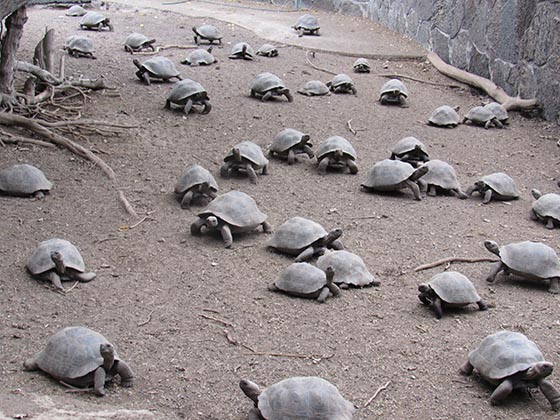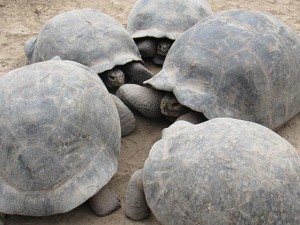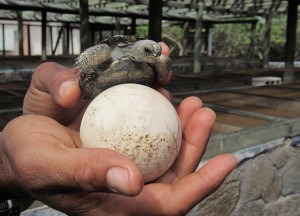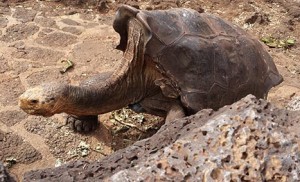Reporting back from the Galapagos

By Mary Ting
During winter break, I had the opportunity to be part of a twelve-day tortoise conservation-focused tour to the Galapagos Islands organized by Russell Burke, biology professor at Hofstra University. The group included a number of noted turtle scientists, graduate students and interested citizens. Luis Rodriguez (Champi), the No. 1-rated Galapagos National Park naturalist guide accompanied the group each day, providing invaluable insight and access.
The Galapagos are an archipelago of volcanic islands off of Ecuador. Due to their geographic isolation, the Galapagos Islands evolved with their original biodiversity intact. Naturalists today continue to be in awe of the vast number of endemic flora and fauna on the islands, made famous by Charles Darwin’s discoveries beginning in 1835. It is only on these islands that the evolutionary process can be made obvious to all. Darwin’s finches are known for their variations in beak sizes based on the available seed size, and differ widely on each island. Likewise, the shells of the giant Galapagos tortoises also vary in shape from island to island, forming different species. Ranging from dome to saddleback with variations in between, the shape of the shell and the length of the necks adapted to the available vegetation.
With the late arrival of humans to the islands, the animals evolved to be unafraid of the threat of people and have remained so. This trait is the greatest attraction to the islands for tourists and also the cause for tragic and disastrous historic encounters. 18th– and 19th-century whalers took record numbers of tortoises on board for food. During World War II, a U.S. military base was set up on Baltra Island and the docile land iguanas were used for target practice, decimating the species. As recently as 1959, Galapagos tortoise oil was used to light the streets of Guayaquil, Ecuador. Invasive animals, including fire ants, rats, dogs, cats, and pigs – which were brought onto the islands intentionally and inadvertently by people – destroy the tortoise eggs, while goats eat the tortoises’ food source. This has led to the extinction of some tortoise species and the threatened existence of others.

The Galapagos National Park was created in 1960 to manage and protect the biodiversity of the island ecosystems and prevent the extinction of iconic species. Ninety-seven percent of the islands were defined as protected natural areas with the remaining three percent designated for human communities around the ports. The shortage of fresh water, active volcanoes and rough terrain make life on the islands difficult for humans. However, the higher wages on the islands have caused the local population to grow to the alarming number of 40,000. Tourists flock to the islands at the rate of 200,000 per year. The increasing energy consumption, dependence on goods shipped from the mainland, and the continual risk of introducing additional invasive flora and fauna put the unique and pristine Galapagos ecosystem at risk.

One of the primary efforts of the Galapagos National Park is to protect the iconic Galapagos tortoises from extinction. At the breeding centers on the islands of Isabella, Floreana, Santa Cruz, and San Cristobal, the tortoises are kept in pens, eggs are incubated, hatchlings are raised in captivity, and larger juveniles are released via helicopter into remote areas. The tortoises are monitored, tracked and have been deemed successful with the sightings of wild hatchlings. The centers vary in the style of pens and the species that are bred and reintroduced. In contrast to the infamous Lonesome George, who died as the last Pinta Tortoise, there is the largely unknown success story of Diego, an Espanola saddle back tortoise. Taken in 1906 from Espanola and brought to San Diego Zoo, Diego was brought back to the islands where his species was near extinction. Since his return, Diego has fathered the bulk of the 1,600 offspring.

The tour group that I traveled with also visited a number of privately owned lands that maintained tortoise habitat. Reservo Pajaro Brujo, a private reserve in Santa Cruz featured fully sustainable living and restoration of original habitat, along with youth programs and waste management systems.
The private coffee plantation, Lava Java was also featured with its rain washed, sun dried 100% organic coffee run by two conservationists, Maria Elena Guerra and Scott Anderson who also train locals to grow native plants and eradicate invasive ones.
In spite of the many breeding success stories, constant vigilance is needed to combat invasive species, illegal harvesting of Galapagos sea cucumber and shark finning. Further complicated by the burgeoning human population, the task of protecting the Galapagos National Park is particularly daunting. Fortunately, the current government in Ecuador has shown serious attention to these issues, limiting the number of building permits, raising the park entrance fee, and increasing crucial public awareness. Future management plans include more restrictions, which are protective of the entire Galapagos, including the human-populated areas and not strictly the Park. The commitment of the Ecuadorean government to protect the unique and fragile Galapagos ecosystem bodes well and cause for guarded optimism.
 Mary Ting is a Professor in the SEJ program and the Art & Music Department at John Jay College of Criminal Justice. Her post and photos stem from a brown bag lunch talk on her experience in the Galapagos that she gave at the college earlier this month. Currently, Professor Ting is preparing an art exhibition that will be unveiled in June. It highlights the endangered species crisis, in particular elephant poaching and ivory, and will be shown at the Chinese American Arts Council, 456 Gallery, New York City. While most people are aware of China as the No. 1 market for ivory trade, few realize that the United States is No. 2– with New York City leading the nation’s market. Watch this website for announcements about the exhibition and related programming.
Mary Ting is a Professor in the SEJ program and the Art & Music Department at John Jay College of Criminal Justice. Her post and photos stem from a brown bag lunch talk on her experience in the Galapagos that she gave at the college earlier this month. Currently, Professor Ting is preparing an art exhibition that will be unveiled in June. It highlights the endangered species crisis, in particular elephant poaching and ivory, and will be shown at the Chinese American Arts Council, 456 Gallery, New York City. While most people are aware of China as the No. 1 market for ivory trade, few realize that the United States is No. 2– with New York City leading the nation’s market. Watch this website for announcements about the exhibition and related programming.